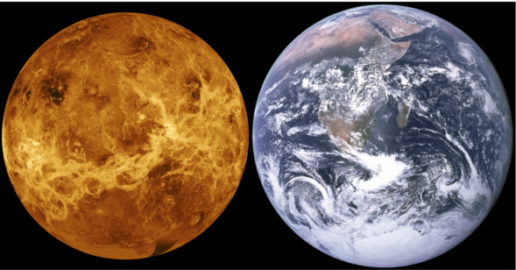- Series:Astronomy, Transcript English
Psalm 8:3-4
“When I consider thy heavens, the work of thy fingers, the moon and the stars, which thou hast ordained; what is man, that thou art mindful of him? and the son of man, that thou visitest him?”
 Venus is the planet, whose orbit brings it closest to that of the Earth. Its closest approach is about 25 million miles, and the two planets make this close approach once every 584 days. It is also the planet most similar in size and mass to the Earth. There are those who would once have described Venus as Earth’s twin. Science fiction writers, early in the 20th Century, such as C.S. Lewis, and Isaac Asimov, informed by contemporary science, described Venus as a habitable place.
Venus is the planet, whose orbit brings it closest to that of the Earth. Its closest approach is about 25 million miles, and the two planets make this close approach once every 584 days. It is also the planet most similar in size and mass to the Earth. There are those who would once have described Venus as Earth’s twin. Science fiction writers, early in the 20th Century, such as C.S. Lewis, and Isaac Asimov, informed by contemporary science, described Venus as a habitable place.
Today, we are startled at how different our twin planet is. Completely covered in an atmosphere, mostly of carbon dioxide, with some nitrogen and sulfur dioxide, the planet’s surface is the hottest of any planet in the Solar System, due to its runaway greenhouse effect. Venus orbits the Sun once every 224.7 days, but rotates on its axis once every 243 Earth days. Its axial rotation is also in the opposite direction to that of the Earth, and most other planets. How is this possible, if the Earth and Venus were formed from the same solar dust cloud, at about the same time, rotating in the same direction? How is it that the Earth has a magnetic field, while Venus does not? How is it that the Earth has a moon – The Moon – while Venus does not?
If Venus is Earth’s twin, it is a non-identical twin. As separate creations, these differences make sense, but evolutionary explanations of these planets’ formations does not.
Prayer: We acknowledge, Lord, that it is the Earth that You have made to be inhabited and not anywhere else. Thank You for this demonstration of Your glory. Amen.
Author: Paul F. Taylor
Ref: Sarfati, J., Venus: Cauldron of fire, Creation 23(3):30–34—June 2001. Image: Comparison of Venus and Earth, NASA, Public Domain.
© 2019 Creation Moments All rights reserved.
